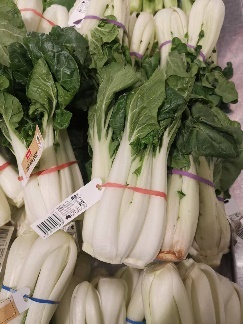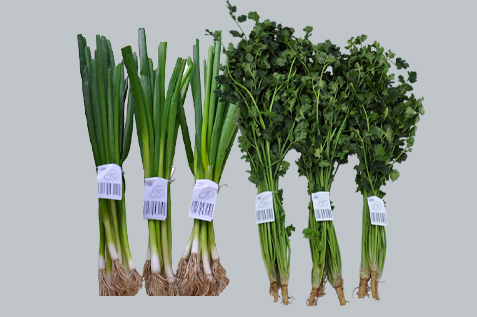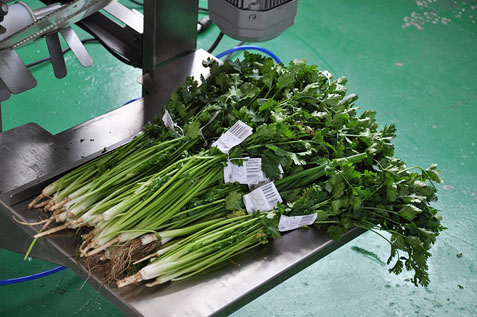Vegetables sold in supermarkets require appropriate packaging before being shelved. Most leafy vegetables and some root vegetables, such as celery, leeks, green onions, and yams, are typically bundled and affixed with barcode or QR code labels for scanning at checkout counters.
Currently, two main bundling methods are commonly used. The first involves manual bundling using rubber bands, with the barcode label either pressed under or clipped onto the rubber band. The drawback of this method is its high labor requirement and low efficiency.
The second method uses a dedicated rectangular plastic strap bundling machine that employs heat-sealed plastic straps. While cost-effective, this method cannot be integrated into an assembly line for continuous operation. It still requires manual handling bundle by bundle, resulting in limited efficiency. Additionally, plastic straps are not environmentally friendly, and attaching barcode labels is inconvenient.
The images below show common bundling methods used in supermarkets:

After more than three years of collaborative research, Yantai Equation Mechanical Technology Co., Ltd. and Dutch company PackTTI have developed a novel vegetable bundling solution for supermarkets based on elastic cord bundling technology. This system is named the "Vegetable Assembly Line Bundling Machine with Instant Barcode Label Printing," as shown below:

This assembly line bundling machine consists of a main frame, a label printing and applicator unit, and an elastic cord bundling machine (also known as a tying machine).
The main frame is constructed from 304 stainless steel and features a conveyor belt equipped with V-shaped clamps. Operators place the vegetables into these V-shaped clamps, and the vegetables are then transported forward by the conveyor belt.
The elastic cord bundling machine, developed by the Dutch company Cyklop, differs from rectangular plastic strap machines by its "pass-through" capability, allowing integration into assembly lines for continuous operation. When vegetables approach the bundling machine, a switch is triggered, causing the tying arm to swiftly descend to complete a bundle before retracting to standby mode.
Elastic cord bundling offers two additional advantages: it is environmentally friendly and pollution-free, and its tension is adjustable to avoid damaging the vegetables.
The label printing and applicator unit was independently developed by Yantai Equation Mechanical specifically for this bundling method. A dedicated inkjet printer, connected to a PC, is pre-loaded with product information, barcodes, and print quantities. After initialization, it enters a real-time printing state. Printed labels are fed by a labeling mechanism to the application head, where they are held by air suction. After the bundling machine completes a bundle, it sends an electrical signal. The application head, carrying the label, moves forward, folds the label in half, applies it to the elastic cord of the bundle, and quickly retracts. The label is transferred onto the vegetable bundle during the next bundling action.


This innovative vegetable assembly line bundling system performs instant label printing, application, and bundling in a continuous flow, creatively addressing the industry's challenges in batch vegetable bundling. With a maximum production efficiency of 1,800 bundles per hour, it improves productivity more than tenfold compared to traditional methods and significantly reduces labor costs.
For details, please visit: https://www.equationtec.com
Baoqing Li
Dep. of Technology
baoqing@equationtec.com